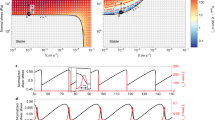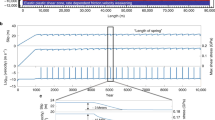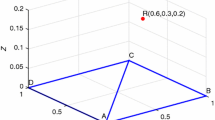Abstract
The development of the rate- and state-dependent friction framework (Dieterich Appl Geophys 116:790–806, 1978; J Geophys Res 84, 2161–2168, 1979; Ruina Friction laws and instabilities: a quasistatic analysis of some dry friction behavior, Ph.D. Thesis, Brown Univ., Providence, R.I., 1980; J Geophys Res 88:10359–10370, 1983) includes the dependence of friction coefficient on normal stress (Linker and Dieterich J Geophys Res 97:4923–4940, 1992); however, a direct dependence of the friction law on time-varying normal stress in dynamic stepover and dip-slip fault models has not yet been extensively explored. Using rate- and state-dependent friction laws and a 2-D dynamic finite element code (Barall J Int 178, 845–859, 2009), we investigate the effect of the Linker–Dieterich dependence of state variable on normal stress at stepovers and dip-slip faults, where normal stress should not be constant with time (e.g., Harris and Day J Geophys Res 98:4461–4472, 1993; Nielsen Geophys Res Lett 25:125–128, 1998). Specifically, we use the relation dψ/dt = −(α/σ)(dσ/dt) from Linker and Dieterich (J Geophys Res 97:4923–4940, 1992), in which a change in normal stress leads to a change in state variable of the opposite sign. We investigate a range of values for alpha, which scales the impact of the normal stress change on state, from 0 to 0.5 (laboratory values range from 0.2 to 0.56). For stepovers, we find that adding normal-stress dependence to the state variable delays or stops re-nucleation on the secondary fault segment when compared to normal-stress-independent state evolution. This inhibition of jumping rupture is due to the fact that re-nucleation along the secondary segment occurs in areas of decreased normal stress in both compressional and dilational stepovers. However, the magnitude of such an effect differs between dilational and compressional systems. Additionally, it is well known that the asymmetric geometry of reverse and normal faults can lead to greater slip and a greater peak slip rate on reverse faults than on normal faults, given the same initial conditions for each (Nielsen Geophys Res Lett 25:125–128, 1998; Oglesby et al. Science 280:1055–1059, 1998; Oglesby and Archuleta J Geophys Res 105:13643–13653, 2000; Oglesby et al. Bull Seismol Soc Am 90:616–628, 2000). For dip-slip models, we find that adding the Linker–Dieterich normal stress dependence to the state variable serves to mitigate differences in peak slip rate between reverse and normal fault models. However, differences in total slip among reverse and normal fault models remain relatively unchanged. We also examine effects from initial shear stress (loading stress) and effects from incorporating a rate-strengthening zone on the uppermost portion of a reverse and a normal fault.

















Similar content being viewed by others
References
Abrahamson, N. A., & Somerville, P. G. (1996). Effects of the hanging wall and footwall on ground motions recorded during the Northridge Earthquake. Bulletin of the Seismological Society of America, 86, S93–S99.
Allen, C. R., Brune, J. N., Cluff, L. S., & Barrows, Allan G., Jr. (1998). Evidence for unusually strong near-field ground motion on the hanging wall of the San Fernando fault during the 1971 earthquake. Seismological Research Letters, 69, 524–531.
Ampuero, J. P., & Rubin, A. M. (2008). Earthquake nucleation on rate and state faults—Aging and slip laws. Journal of Geophysical Research: Solid Earth. doi:10.1029/2007JB005082.
Andrews, D. J. (1976). Rupture velocity of plane strain shear cracks. Journal of Geophysical Research, 81, 5679–5687.
Andrews, D. J. (1985). Dynamic plane-strain shear rupture with a slip-weakening friction law calculated by a boundary integral method. Bulletin of the Seismological Society of America, 75, 1–21.
Archuleta, R. J. (1984). A faulting model for the 1979 imperial valley earthquake. Journal of Geophysical Research, 89, 4559–4585.
Barall, M. (2008). FaultMod Finite Element Code. http://scecdata.usc.edu/cvws/download/codedesc/Barall_FaultMod_Desc.pdf.
Barall, M. (2009). A grid-doubling finite-element technique for calculating dynamic three-dimensional spontaneous rupture on an earthquake fault. Geophysical Journal International, 178, 845–859.
Berberian, M. (1982). Aftershock tectonics of the 1978 Tabas-e-Golshan (Iran) earthquake sequence: a documented active ‘thin- and thick-skinned tectonic’ case. Geophysical Journal of the Royal Astronomical Society, 68, 499–530.
Brune, J. N. (1996). Particle motions in a physical model of shallow angle thrust faulting. Proceedings of the Indian Academy of Sciences (Earth and Planetary Sciences), 105, L196–L206.
Burridge, R. (1973). Admissible speeds for plane-strain self-similar shear cracks with friction but lacking cohesion. Geophysical Journal of the Royal Astronomical Society, 35, 439–455.
Burridge, R., & Halliday, G. S. (1971). Dynamic shear cracks with friction as models for shallow focus earthquakes. Geophysical Journal of the Royal Astronomical Society, 25, 261–283.
Castro, R. R., Munguia, L., & Brune, J. N. (1995). Source spectra and site response from P and S waves of local earthquakes in the Oaxaca, Mexico, Subduction Zone. Bulletin of the Seismological Society of America, 85, 923–936.
Chester, F. M., & Higgs, N. G. (1992). Multimechanism friction constitutive model for ultrafine quartz gouge at hypocentral conditions. Journal of Geophysical Research, 97, 1859–1870.
Cocco, M., & Rovelli, A. (1989). Evidence for the variation of stress drop between normal and thrust faulting earthquakes in Italy. Journal of Geophysical Research, 94, 9399–9416.
Cochard, A., & Rice, J. R. (2000). Fault rupture between dissimilar materials: Ill-posedness, regularization, and slip-pulse response. Journal of Geophysical Research: Solid Earth, 105, 25891–25907.
Dalguer, L. A., & Day, S. M. (2007). Staggered-grid split-node method for spontaneous rupture simulation. Journal of Geophysical Research. doi:10.1029/2006JB004467.
Dieterich, J. H. (1978). Time-dependent friction and the mechanics of stick-slip. Pure and Applied Geophysics, 116, 790–806.
Dieterich, J. H. (1979). Modeling of Rock Friction 1. Experimental results and constitutive equations. Journal of Geophysical Research, 84, 2161–2168.
Dieterich, J. H. (1992). Earthquake nucleation on faults with rate- and state-dependent strength. Tectonophysics, 211, 115–134.
Duan, B., & Oglesby, D. D. (2006). Heterogeneous fault stresses from previous earthquakes and the effect on dynamics of parallel strike-slip faults. Journal of Geophysical Research. doi:10.1029/2005JB004138.
Elliot, A. J., Dolan, J. F., & Oglesby, D. D. (2009). Evidence from coseismic slip gradients for dynamic control on rupture propagation and arrest through stepovers. Journal of Geophysical Research. doi:10.1029/2008JB005969.
Gabuchian, V., Rosakis, A. J., Lapusta, N., & Oglesby, D. D. (2014). Experimental investigation of strong ground motion due to thrust fault earthquakes. Journal of Geophysical Research: Solid Earth, 119, 1316–1336.
Guatteri, M., & Spudich, P. (2000). What can strong-motion data tell us about slip-weakening fault-friction laws. Bulletin of the Seismological Society of America, 90, 98–116.
Hanks, T. C. (1974). The faulting mechanism of the San Fernando Earthquake. Journal of Geophysical Research, 79, 1215–1229.
Harris, R. A., Archuleta, R. J., & Day, S. M. (1991). Fault steps and the dynamic rupture process: 2-D numerical simulations of a spontaneously propagating shear fracture. Geophysical Research Letters, 18, 893–896.
Harris, R. A., & Day, S. M. (1993). Dynamics of fault interaction—parallel strike-slip faults. Journal of Geophysical Research, 98, 4461–4472.
Harris, R. A., & Day, S. M. (1997). Effects of a Low-Velocity Zone on a Dynamic Rupture. Bulletin of the Seismological Society of America, 87, 1267–1280.
Hyndman, R. D., Yamano, M., & Oleskevich, D. A. (1997). The seismogenic zone of subduction thrust faults. The Island Arc, 6, 244–260.
Kanamori, H. (1972). Mechanism of tsunami earthquakes. Physics of the Earth and Planetary Interiors, 6, 346–359.
Kase, Y., & Kuge, K. (1998). Numerical simulation of spontaneous rupture processes on two non-coplanar faults: the effect of geometry on fault interaction. Geophysical Journal International, 135, 911–922.
Knuepfer, P. L. K. (1989). Implications of the characteristics of endpoints of historical surface fault ruptures for the nature of fault segmentation, US Geol. Surv. Open-file Rep., pp. 193–228.
Kozdon, J. E., & Dunham, E. M. (2012). Rupture to the Trench: Dynamic Simulations of the 11 March 2011 Tohoku Earthquake. Bulletin of the Seismological Society of America. Accepted for publication on 27 August 2012 Special Issue.
Lapusta, N., Rice, J. R., Ben-Zion, Y., & Zheng, G. (2000). Elastodynamic analysis for slow tectonic loading with spontaneous rupture episodes on faults with rate-and state-dependent friction. Journal of Geophysical Research, 105, 23765–23789.
Linker, M. F., & Dieterich, J. H. (1992). Effects of variable normal stress on rock friction: observations and constitutive equations. Journal of Geophysical Research, 97, 4923–4940.
Marone, C., Raleigh, C. B., & Scholz, C. H. (1990). Frictional behavior and constitutive modeling of simulated fault gouge. Journal of Geophysical Research, 95, 7007–7025.
McGarr, A. (1984). Scaling of ground motion parameters, state of stress, and focal depth. Journal of Geophysical Research, 89, 6969–6979.
Nason, R. (1973). Increased seismic shaking above a thrust fault; San Fernando, California, Earthquake of February 9, 1971 (pp. 123–126). Washington, D.C.: US Dept. of Commerce.
Nielsen, S. B. (1998). Free surface effects on the propagation of dynamic rupture. Geophysical Reseach Letters, 25, 125–128.
Oglesby, D. D., & Archuleta, R. J. (2000). Dynamics of dip-slip faulting: explorations in two dimensions. Journal of Geophysical Research, 105, 13643–13653.
Oglesby, D. D., Archuleta, R. J., & Nielsen, S. B. (1998). Earthquakes on dipping faults: the effects of broken symmetry. Science, 280, 1055–1059.
Oglesby, D. D., Archuleta, R. J., & Nielsen, S. B. (2000). The three-dimensional dynamics of dipping faults. Bulletin of the Seismological Society of America, 90, 616–628.
Okubo, P. G. (1989). Dynamic rupture modeling with laboratory-derived constitutive relations. Journal of Geophysical Research, 94, 12321–12335.
Ruina, A. (1980). Friction laws and instabilities: A quasistatic analysis of some dry friction behavior, Ph.D. Thesis. Providence, R. I.: Brown Univ.
Ruina, A. (1983). Slip instability and state variable friction Laws. Journal of Geophysical Research, 88, 10359–10370.
Ryan, K. J. (2012). Dynamic models of earthquake rupture on fault stepovers and dip-slip faults using various friction formulations, M. S. Thesis, Dep. of Earth Sciences, University of California, Riverside.
Ryan, K. J., & Oglesby, D. D. (2014). Dynamically modeling fault step overs using various friction laws. Journal of Geophysical Research, 119(7), 5814–5829.
Scholz, C. H. (1998). Earthquakes and friction laws. Nature, 391, 37–42.
Tsutsumi, A., & Shimamoto, T. (1997). High-velocity frictional properties of gabbro. Geophysical Research Letters, 24, 699–702.
Wesnousky, S. G. (1988). Seismological and structural evolution of strike-slip faults. Nature, 335, 340–343.
Wesnousky, S. G. (2006). Predicting the endpoints of earthquake ruptures. Nature, 444, 358–360.
Zheng, G., & Rice, J. R. (1998). Conditions under which velocity-weakening friction allows a self-healing versus a cracklike mode of rupture. Bulletin of the Seismological Society of America, 88, 1466–1483.
Acknowledgements
The FEM earthquake rupture code (FaultMod) used in this study is documented at http://scecdata.usc.edu/cvws/download/codedesc/Barall_FaultMod_Desc.pdf. We are greatly appreciative to Michael Barall for his expertise and for his guidance in the use of the FEM code FaultMod. We thank Elizabeth Cochran and Jim Dieterich for their thoughtful discussions and helpful comments that greatly improved this study. We also thank Fabian Bonilla and an anonymous reviewer for their thoughtful critiques and comments that furthered this study. This work was supported by NSF Grant EAR-0838464.
Author information
Authors and Affiliations
Corresponding author
Rights and permissions
About this article
Cite this article
Ryan, K.J., Oglesby, D.D. Modeling the Effects of a Normal-Stress-Dependent State Variable, Within the Rate- and State-Dependent Friction Framework, at Stepovers and Dip-Slip Faults. Pure Appl. Geophys. 174, 1361–1383 (2017). https://doi.org/10.1007/s00024-017-1469-2
Received:
Revised:
Accepted:
Published:
Issue Date:
DOI: https://doi.org/10.1007/s00024-017-1469-2




